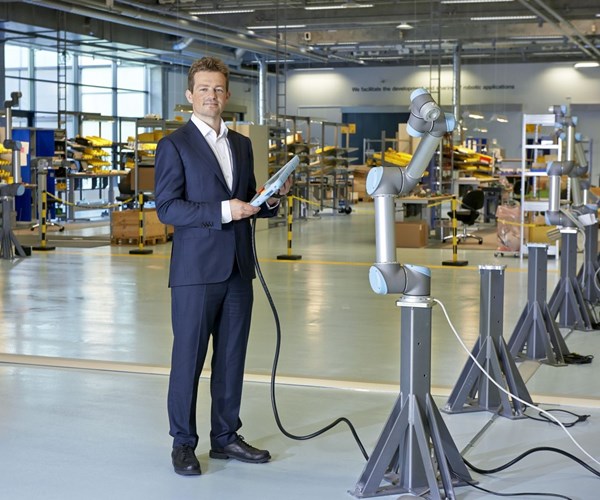Co-founder and CTO of Universal Robots Wins Engelberger Award
The Robotic Industries Association (RIA) announced Esben Østergaard, co-founder and chief technology officer of Universal Robots, as the recipient of the Engelberger Robotics Award.

The Robotic Industries Association (RIA) announced Esben Østergaard, co-founder and chief technology officer of Universal Robots, as the recipient of the Engelberger Robotics Award. Mr. Østergaard spearheads the development of Universal Robots’ collaborative robot arms, which has proven to be a significant technology breakthrough for the robotics community.
President of RIA, Jeff Burnstein, describes Mr. Østergaard as a visionary in defining a new category of robotics. “His work in the field of collaborative robot applications has allowed robots to enter previously unthinkable sectors in just about every industry,” says Mr. Burnstein. “Esben Østergaard’s emphasis on robots that work side-by-side with people and are easy to use has created enormous interest among many small and medium-sized companies who never even considered robots before. In a world that is increasingly characterized by people and robots working together, Esben’s pioneering technology advances play a pivotal role.”
Featured Content
“I’m deeply honored to win the award named after Joseph Engelberger, who revolutionized industrial manufacturing with robotics,” says Mr. Østergaard. “Engelberger’s view that a robot should be able to handle a range of tasks in a factory aligns with Universal Robots’ core mission, and I’m a great admirer of his work.” Mr. Østergaard leads a team of developers that launched 3D robot programming via an intuitive tablet interface. Designed to be user-friendly, yet sophisticated, this system has enabled users with no previous programming experience to quickly set up and operate the UR robots.
He also developed the robot’s force and safety control features, which ensure that if the robot collides with a person, the robot automatically stops operating and does not cause bodily harm, adhering to the current safety requirements on force and torque limitations. These features have eliminated the need for safety guarding in a majority of the UR robot applications currently installed and remain a trailblazer for the “collaborative robot” concept.
“We want to place control of factory automation back into the hands of operators. Instead of replacing people we want to give them a tool to do their work more efficiently,” Mr. Østergaard says. “We want to remove them from working like robots to becoming robot programmers and handling more value-added tasks. Doing this will perhaps be the best long-term result derived from leveraging collaborative robots.”
RELATED CONTENT
-
Automation in High-Mix, Low-Volume Turning Applications
Turning shops are familiar with automation for high-volume work, but the shifting landscape to smaller batch sizes has created new challenges.
-
What Is The Best Bar Feed System For Production Turning?
Selecting the right bar feeder can be one of the most important decisions a shop can make. Bar feed systems help improve productivity, throughput and quality, but in order to achieve the most benefit from them it is essential that a bar feed system be matched to the particular needs of the turning operation.
-
Bar Feeder Basics
Some primary factors are often overlooked when considering how to justify the implementation of a bar feeder for turning operations.






